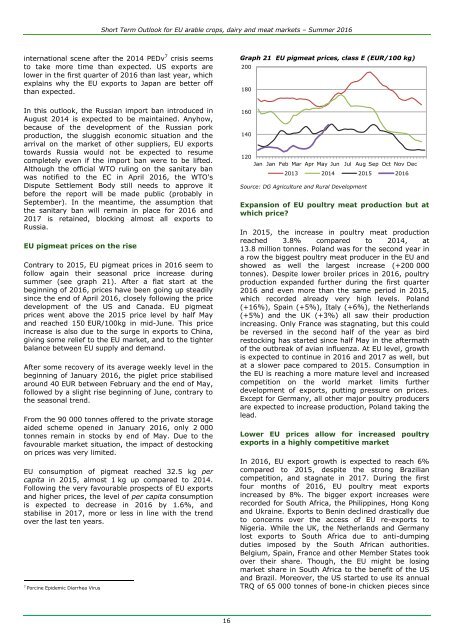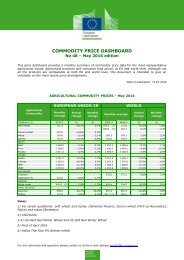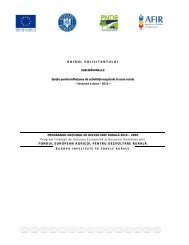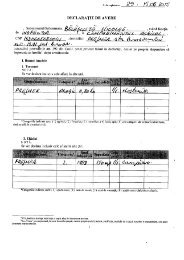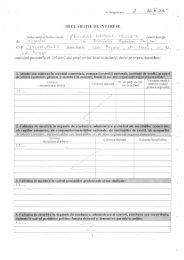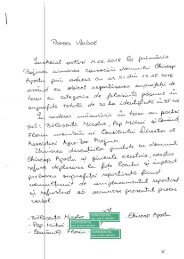Create successful ePaper yourself
Turn your PDF publications into a flip-book with our unique Google optimized e-Paper software.
Short Term Outlook for EU arable crops, dairy and meat markets – Summer <strong>2016</strong><br />
international sc<strong>en</strong>e after the 2014 PEDv 7 crisis seems<br />
to take more time than expected. US exports are<br />
lower in the first quarter of <strong>2016</strong> than last year, which<br />
explains why the EU exports to Japan are better off<br />
than expected.<br />
Graph 21 EU pigmeat prices, class E (EUR/100 kg)<br />
200<br />
180<br />
In this outlook, the Russian import ban introduced in<br />
August 2014 is expected to be maintained. Anyhow,<br />
because of the developm<strong>en</strong>t of the Russian pork<br />
production, the sluggish economic situation and the<br />
arrival on the market of other suppliers, EU exports<br />
towards Russia would not be expected to resume<br />
completely ev<strong>en</strong> if the import ban were to be lifted.<br />
Although the official WTO ruling on the sanitary ban<br />
was notified to the EC in April <strong>2016</strong>, the WTO's<br />
Dispute Settlem<strong>en</strong>t Body still needs to approve it<br />
before the report will be made public (probably in<br />
September). In the meantime, the assumption that<br />
the sanitary ban will remain in place for <strong>2016</strong> and<br />
2017 is retained, blocking almost all exports to<br />
Russia.<br />
EU pigmeat prices on the rise<br />
Contrary to 2015, EU pigmeat prices in <strong>2016</strong> seem to<br />
follow again their seasonal price increase during<br />
summer (see graph 21). After a flat start at the<br />
beginning of <strong>2016</strong>, prices have be<strong>en</strong> going up steadily<br />
since the <strong>en</strong>d of April <strong>2016</strong>, closely following the price<br />
developm<strong>en</strong>t of the US and Canada. EU pigmeat<br />
prices w<strong>en</strong>t above the 2015 price level by half May<br />
and reached 150 EUR/100kg in mid-June. This price<br />
increase is also due to the surge in exports to China,<br />
giving some relief to the EU market, and to the tighter<br />
balance betwe<strong>en</strong> EU supply and demand.<br />
After some recovery of its average weekly level in the<br />
beginning of January <strong>2016</strong>, the piglet price stabilised<br />
around 40 EUR betwe<strong>en</strong> February and the <strong>en</strong>d of May,<br />
followed by a slight rise beginning of June, contrary to<br />
the seasonal tr<strong>en</strong>d.<br />
From the 90 000 tonnes offered to the private storage<br />
aided scheme op<strong>en</strong>ed in January <strong>2016</strong>, only 2 000<br />
tonnes remain in stocks by <strong>en</strong>d of May. Due to the<br />
favourable market situation, the impact of destocking<br />
on prices was very limited.<br />
EU consumption of pigmeat reached 32.5 kg per<br />
capita in 2015, almost 1 kg up compared to 2014.<br />
Following the very favourable prospects of EU exports<br />
and higher prices, the level of per capita consumption<br />
is expected to decrease in <strong>2016</strong> by 1.6%, and<br />
stabilise in 2017, more or less in line with the tr<strong>en</strong>d<br />
over the last t<strong>en</strong> years.<br />
7<br />
Porcine Epidemic Diarrhea Virus<br />
160<br />
140<br />
120<br />
Jan Jan Feb Mar Apr May Jun Jul Aug Sep Oct Nov Dec<br />
2013 2014 2015 <strong>2016</strong><br />
Source: DG Agriculture and Rural Developm<strong>en</strong>t<br />
Expansion of EU poultry meat production but at<br />
which price?<br />
In 2015, the increase in poultry meat production<br />
reached 3.8% compared to 2014, at<br />
13.8 million tonnes. Poland was for the second year in<br />
a row the biggest poultry meat producer in the EU and<br />
showed as well the largest increase (+200 000<br />
tonnes). Despite lower broiler prices in <strong>2016</strong>, poultry<br />
production expanded further during the first quarter<br />
<strong>2016</strong> and ev<strong>en</strong> more than the same period in 2015,<br />
which recorded already very high levels. Poland<br />
(+16%), Spain (+5%), Italy (+6%), the Netherlands<br />
(+5%) and the UK (+3%) all saw their production<br />
increasing. Only France was stagnating, but this could<br />
be reversed in the second half of the year as bird<br />
restocking has started since half May in the aftermath<br />
of the outbreak of avian influ<strong>en</strong>za. At EU level, growth<br />
is expected to continue in <strong>2016</strong> and 2017 as well, but<br />
at a slower pace compared to 2015. Consumption in<br />
the EU is reaching a more mature level and increased<br />
competition on the world market limits further<br />
developm<strong>en</strong>t of exports, putting pressure on prices.<br />
Except for Germany, all other major poultry producers<br />
are expected to increase production, Poland taking the<br />
lead.<br />
Lower EU prices allow for increased poultry<br />
exports in a highly competitive market<br />
In <strong>2016</strong>, EU export growth is expected to reach 6%<br />
compared to 2015, despite the strong Brazilian<br />
competition, and stagnate in 2017. During the first<br />
four months of <strong>2016</strong>, EU poultry meat exports<br />
increased by 8%. The bigger export increases were<br />
recorded for South Africa, the Philippines, Hong Kong<br />
and Ukraine. Exports to B<strong>en</strong>in declined drastically due<br />
to concerns over the access of EU re-exports to<br />
Nigeria. While the UK, the Netherlands and Germany<br />
lost exports to South Africa due to anti-dumping<br />
duties imposed by the South African authorities.<br />
Belgium, Spain, France and other Member States took<br />
over their share. Though, the EU might be losing<br />
market share in South Africa to the b<strong>en</strong>efit of the US<br />
and Brazil. Moreover, the US started to use its annual<br />
TRQ of 65 000 tonnes of bone-in chick<strong>en</strong> pieces since<br />
16


